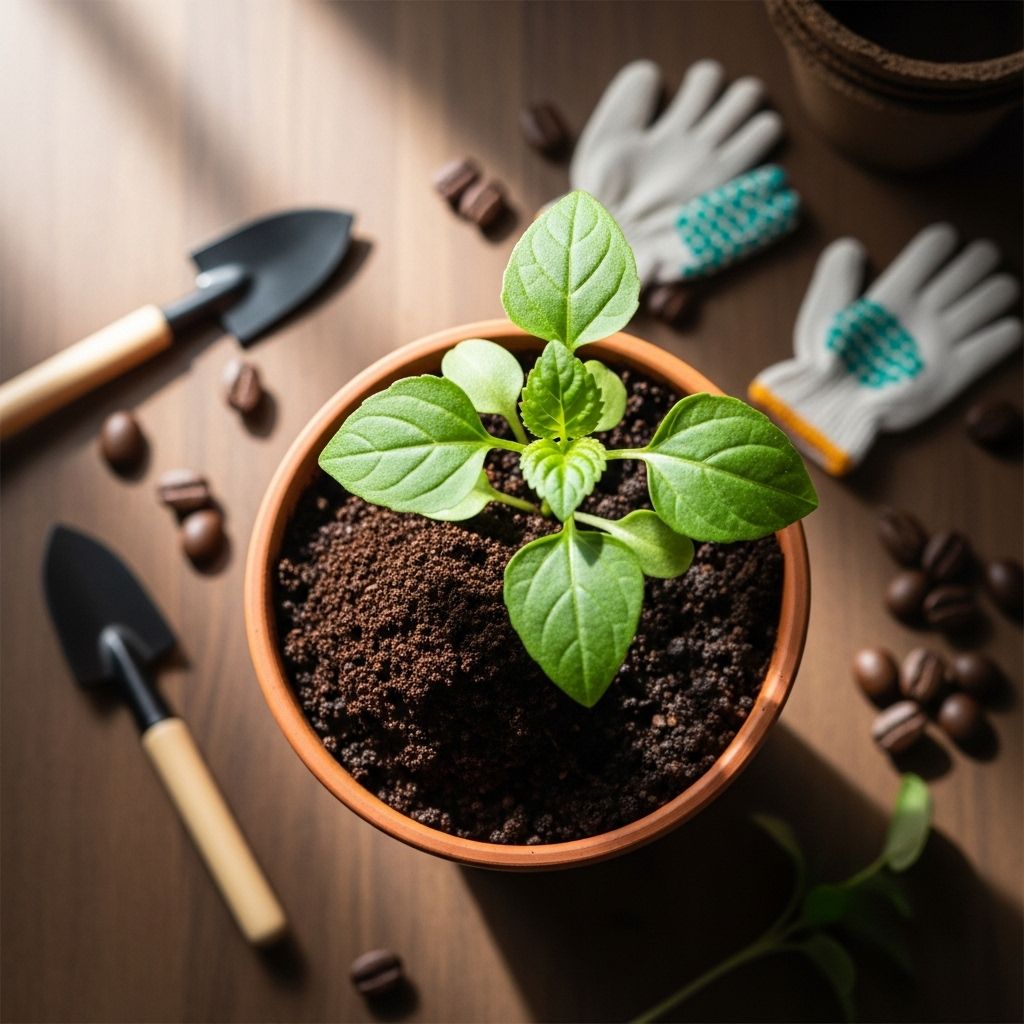Coffee Grounds For Plants: 5 Ways To Use Them Safely
Unlock greener growth with natural waste tricks, tips, and truths for thriving gardens.

Image: HearthJunction Design Team
How to Use Coffee Grounds for Plants: Benefits, Best Practices, and Myths
For gardeners and coffee enthusiasts alike, recycling used coffee grounds in the garden has become a popular way to repurpose waste while adding nutrients to the soil. But are coffee grounds actually good for your plants? This comprehensive guide will break down the facts and best practices for using coffee grounds around your garden, highlight plants that benefit most, clear up myths, and share tips on composting, pest management, and more.
Are Coffee Grounds Good for Plants?
Coffee grounds are considered an excellent compost ingredient and can be applied directly to the soil of most garden plants—if used with care and moderation. They contain macronutrients and trace minerals that plants need for healthy growth, including:
- Nitrogen – promotes leafy growth
- Potassium – supports flowering and fruiting
- Phosphorus – aids in root development
- Organic matter – improves soil structure
Additionally, coffee grounds can help feed beneficial soil microbes, leading to improved drainage and soil aeration over time.
Potential Drawbacks and Myths
Despite their benefits, coffee grounds should not be considered a one-size-fits-all solution. Here are some commonly misunderstood aspects:
- Clumping effect: Used in large quantities directly on soil, fine coffee particles can bind together and form a layer that repels water and air, leading to poor root health.
- Caffeine toxicity: Coffee plants produce caffeine to deter competitors, and grounds can still hold some caffeine after brewing, which may negatively affect young seedlings or delicate plants by inhibiting germination and growth.
- Acidity myths: Although brewed coffee is acidic, used coffee grounds tend to be near neutral (pH 6.5–6.8) and do not significantly acidify garden soil.
- Mineral content: While coffee grounds do contain nutrients, their availability to plants is limited unless the grounds are composted first.
Best Practices for Using Coffee Grounds in the Garden
1. Composting Coffee Grounds
The safest and most effective way to use coffee grounds is to add them to a compost pile or worm bin. Their moist, fine texture helps mix and break down dry, woody waste, accelerating the composting process. When fully composted, coffee grounds contribute balanced nutrients to garden soil without the risks associated with direct application.
- Always mix coffee grounds with dry materials like leaves and shredded paper to prevent a soggy, compact compost pile.
- Un-used coffee (liquid) can also be added to compost or used to moisten dry compost ingredients.
2. Direct Application as Mulch or Soil Amendment
If you wish to apply coffee grounds directly to your soil:
- Sprinkle in a thin, even layer around established plants, and gently work them into the top layer of soil.
- Avoid creating thick mats of coffee grounds on the soil surface, as these can inhibit moisture and air from reaching plant roots.
- Never use grounds repeatedly in the same location without mixing with organic mulch or compost.
3. Supporting Soil Structure and Fertility
Incorporating coffee grounds into garden beds can improve:
- Soil texture — grounds break down over time, enhancing aeration and water retention.
- Microbial activity — the organic matter feeds beneficial microbes, contributing to overall plant health.
4. Composting Ratios
| Material Type | Carbon to Nitrogen (C:N) Ratio |
|---|---|
| Coffee Grounds | ~20:1 |
| Brown Leaves | ~60:1 |
| Grass Clippings | ~17:1 |
For best results, strive for a balanced blend of ‘greens’ (nitrogen-rich materials like coffee grounds) and ‘browns’ (carbon-rich materials like shredded leaves).
Coffee Grounds as Natural Pest Control
Some gardeners use coffee grounds to repel pests, though scientific evidence is limited:
- Slugs and snails: The coarse texture and caffeine in coffee grounds are believed to deter these pests. Scatter a thin layer around vulnerable plants or use weak coffee sprays to target infested areas.
- Cats: Coffee grounds may discourage cats from using garden beds as litter, possibly due to their odor and caffeine content.
Note: While anecdotal reports are promising, always use caution and observe your plants for any negative effects, especially if using around edible crops or seedlings.
Which Plants Like Coffee Grounds?
Although coffee grounds are relatively neutral in pH after brewing, certain plants are more tolerant and even benefit from their application, particularly those preferring organically-enriched soil. According to expert sources, here are several garden plants that can thrive with the addition of composted or well-mixed coffee grounds:
- Roses
- Rhododendrons
- Azaleas
- Blueberries
- Hydrangeas
- Lily of the valley
- Hollies
- Camellias
- Gardenias
- Carrots
These plants often appreciate slightly acidic conditions and organic soil amendments. However, as always, test coffee grounds on one or two plants before widespread use, and avoid using them on seedlings or young transplants.
Plants That Should Avoid Coffee Grounds
Some crops and plants are sensitive to caffeine or the moisture-retaining properties of coffee grounds and may be harmed by direct application, especially in high quantities. These include:
- Tomatoes (seedlings and young plants)
- Alfalfa
- Clovers
- Other legumes
Always observe plant health after applying coffee grounds and discontinue use if you notice signs of stress or stunted growth.
Tips for Recycling Coffee Grounds in the Garden
- Let used coffee grounds cool and dry before applying to prevent mold growth.
- Do not add large volumes at once — moderation is key.
- Regularly rotate the areas where you use coffee grounds to avoid nutrient imbalances.
- Combine coffee grounds with other compost ingredients for best results.
- Test unfamiliar plants with small amounts before applying grounds widely.
Common Myths About Coffee Grounds in the Garden
- Myth: Coffee grounds significantly acidify soil.
Fact: Spent grounds are close to pH neutral; their effect on soil pH is minimal and short-lived. - Myth: Coffee grounds are a source of all essential nutrients.
Fact: While rich in nitrogen, potassium, and phosphorus, they lack the full range of nutrients plants need and should not replace a balanced fertilizer. - Myth: Coffee grounds are universally safe for all plants.
Fact: Sensitive species and young seedlings can be negatively impacted, especially if caffeine content remains high.
FAQs: Coffee Grounds for Plants
Q: Will coffee grounds make my soil too acidic?
A: No. Used coffee grounds are only mildly acidic to nearly neutral, so they will not drastically change your soil’s pH.
Q: Can I sprinkle coffee grounds directly around my plants?
A: You can, but do so sparingly and always mix into the soil or combine with other organic materials. Avoid applying thick layers, especially near delicate plants or seedlings.
Q: How do coffee grounds help my compost?
A: Coffee grounds provide nitrogen, improve moisture retention, and help balance the ‘green’ to ‘brown’ ratio in compost heaps, speeding up decomposition and creating richer soil.
Q: Will coffee grounds repel pests in my garden?
A: Some gardeners report success with slugs, snails, and cats, but results are inconsistent, and more research is needed. Use as part of an integrated pest management approach.
Q: Should I avoid coffee grounds on vegetables?
A: Use caution with high-caffeine crops or when direct application could lead to excess moisture retention. Composting is the safest way to use coffee grounds for edibles.
Final Thoughts
Coffee grounds are a valuable, sustainable addition to most gardens when used with care. They enrich compost, support soil structure, and may even help deter some pests. However, moderation and careful application are key—avoid using thick layers, keep away from seedlings and young plants, and always observe the health of your garden after application. By integrating coffee grounds into your composting and mulching routines, you can reduce waste and give your plants a gentle nutritional boost.
References
- https://www.gardenersworld.com/how-to/maintain-the-garden/coffee-grounds-for-plants/
- https://www.youtube.com/watch?v=nkmFLtGW3BQ
- https://www.marthastewart.com/how-to-use-coffee-grounds-garden-11681230
- https://lawnlove.com/blog/using-coffee-grounds-in-your-garden/
- https://www.southernliving.com/plants-that-like-coffee-grounds-11716739
Read full bio of medha deb












